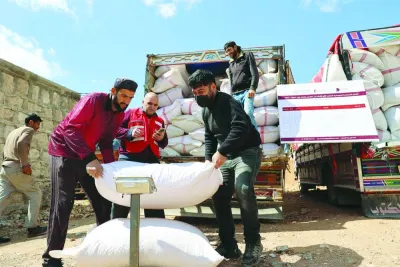Syria’s longest river used to flow by his olive grove, but today Khaled al-Khamees says it has receded into the distance, parching his trees and leaving his family with hardly a drop to drink.
“It’s as if we were in the desert,” said the 50-year-old farmer, standing on what last year was the Euphrates riverbed.
“We’re thinking of leaving because there’s no water left to drink or irrigate the trees.”
Aid groups and engineers are warning of a looming humanitarian disaster in northeast Syria, where waning river flow is compounding woes after a decade of war.
They say plummeting water levels at hydroelectric dams since January are threatening water and power cutoffs for up to five million Syrians, in the middle of a coronavirus pandemic and economic crisis.
Outside the village of Rumayleh where Khamees lives, black irrigation hoses lay in dusty coils after the river receded so far it became too expensive to operate the water pumps.
Instead, much closer to the water’s edge, Khamees and neighbours were busy planting corn and beans in soil just last year submerged under the current.
The father of 12 said he had not seen the river so far away from the village in decades.
“The women have to walk seven km just to get a bucket of water for their children to drink,” he said.
Reputed to have once flown through the biblical Garden of Eden, the Euphrates runs for almost 2,800km across Turkey, Syria and Iraq.
In times of rain, it gushes into northern Syria through the Turkish border, and flows diagonally across the war-torn country towards Iraq.
Along its way, it irrigates swathes of land in Syria’s breadbasket, and runs through three hydroelectric dams that provide power and drinking water to millions.
But over the past eight months the river has contracted to a sliver, sucking precious water out of reservoirs and increasing the risk of dam turbines grinding to a halt.
At the Tishrin Dam, the first into which the river falls inside Syria, director Hammoud al-Hadiyyeen described an “alarming” drop in water levels not seen since the dam’s completion in 1999.
“It’s a humanitarian catastrophe,” he said.
Since January, the water level has plummeted by 5m, and now hovers just dozens of centimetres above “dead level” when turbines are supposed to completely stop producing electricity.
Across northeast Syria, already power generation has fallen by 70% since last year, the head of the energy authority Welat Darwish says.
Two out of three of all potable water stations along the river are pumping less water or have stopped working, humanitarian groups say.
Fresh water supply on another river has been disrupted at least 24 times since 2019, affecting 460,000 people, the United Nations says.
“The big picture is drought is coming,” Syria analyst Fabrice Balanche said. “We already see a rapid decline in healthy vegetation growth on satellite analysis in Syria”.
A UN climate change report this month found human influence had almost definitely increased the frequency of simultaneous heatwaves and droughts worldwide.
These dry spells are to become longer and more severe around the Mediterranean, the United Nations has warned, with Syria most at risk, according to the 2019 Global Crisis Risk Index.
Downstream from the Tishrin Dam, the Euphrates pools in the depths of Lake Assad.
But today Syria’s largest fresh water reservoir too has withdrawn inwards.
On its banks, men with tar-stained hands worked to repair generators exhausted from pumping water across much further distances than in previous years.
Agricultural worker Hussein Saleh, 56, was desperate.
“We can no longer afford the hoses or the generators,” said the father of 12.
“The olive trees are thirsty and the animals are hungry.”
At home, in the village of Twihiniyyeh, power cuts had increased from nine to 19 hours a day, he said.
At the country’s largest dam of Tabqa to the south, veteran engineer Khaled Shaheen was worried.
“We’re trying to diminish how much water we send through,” he said.
But “if it continues like this, we could stop electricity production for all except... bakeries, flour mills and hospitals.” — AFP



